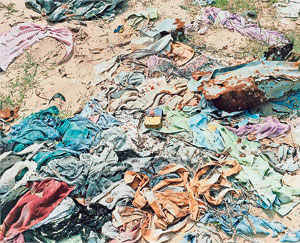Documenting the pain of conflict in the ‘Afterlife’
View(s):By Smriti Daniel
Though it’s been a few years, Cassie Machado still remembers that all her research was not enough to prepare her for what she would find in Mullaitivu. “Travelling along the road up from Trinco on the first day I remember very clearly feeling silenced, what I saw and what I felt was and still is desperately upsetting,” she says. “You see, there was really very little left for the people to return to.” There were ruins everywhere she looked, but something in the young photographer responded to that place and its people. “I never looked back, it was a life changing experience.”
Those moments have led Machado to the threshold of her first exhibition. Afterlife opened at the Saskia Fernando Gallery this week and will run till November 20.Machado’s photographs belong to the category of documentary art. There is no oxymoron there, says Machado, explaining that while images that run in the news are often perceived as revealing a total truth, a photograph cannot, in fact, fully capture the complexity of conflict, or even life as it is lived. This is particularly true of Machado’s commitment “to empathise, engage with, make sense of and come to terms with – politically, militarily, socially and ideologically – the subject of an atrocity.”

From the exhibition: Afterlife VII Mullivaikkal
“The questioning of this subject matter and the questioning of the photographic medium itself is indeed something that is at the core of my practice and my interest in documentary art and its potential use as a critical art form,” she says, quoting Jacques Rancierre:‘the images of art do not supply weapons for battle. They help sketch new configurations of what can be seen, what can be said and what can be thought and consequently, a new landscape of the possible.’
Machado’s experimentation is anchored in and responds to the communities she has been working with. Her encounters with people in the former war zones have revealed the trauma people are still grappling with, a grief only exacerbated in cases where families were unable to bury their dead or to observe the funeral rites for the disappeared.
This got the photographer thinking about reincarnation and the possibilities of the afterlife, both which resonate deeply with the island’s Buddhist and Hindu traditions: “I began to think about it specifically in the context of the end of the war in Sri Lanka.” She studied the sequence of funeral rites or dharma shastras, which symbolise stages in the preparation of the body to enable the soul to pass into the afterlife for reincarnation.
“These rituals are believed to be vital in order to facilitate the peaceful onward journey of the atman,” she says, adding that for the living, these rituals were seen as essential to the process of mourning and remembrance, allowing loved ones to reconcile themselves with loss and with its associated trauma.
She found that there were far too many who had been physically unable to perform all, if any, of the traditional funeral rites and that as a result, communities believed their loved ones were now condemned to “wander restlessly in a twilight between the living and the dead, like ghosts.” She was so moved by this that she chose to title her exhibition Afterlife, seeing it as “an attempt to remedy this imbalance by addressing the past, in order to acknowledge it and move on from it in some way.” She saw her body of work “as an acknowledgment and as a sort of burial.”
Though the war had ended, as she went about her research Machado often found access to some areas and communities difficult, or people so worried about repercussions that they would not speak with her. Her own feeling was that what existed and exists below the surface is “a picture that could not and cannot ever be fully captured either through words or through images.” It became clear to her that it was what was felt, rather than what was seen that was of primary importance.
Half-British, half-Sri Lankan, Machado was born and raised in the UK in the very idyllic countryside of West Sussex. “I lived in Sri Lanka for the first year of my life but left during the Black July riots of 1983,” she says, adding that despite her distance and sense of disconnection from the country, she also had a “deep seated craving to know Sri Lanka and to understand more about my heritage.”
So she embarked on a nearly five-year long period of experimentation, as she struggled to shape this exhibition. There were moments when Machado felt overwhelmed. Her ambition was to make something that did not position that viewer as a blind spectator but that sought, instead, to emancipate them. “Each chapter was a new exercise, a new strategy, and a new failure,” she says, acknowledging that searching out a mode of engaging with her chosen theme has been an enormous challenge. Now, having created something she is confident enough to display in a gallery, she says: “It is my hope that something positive can be taken from this.”


